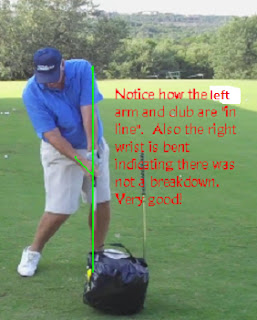Reading a green is like taking a long road trip; you have to use a map to arrive at your destination.
In other words, from your starting point you need to observe all the slopes which will effect the roll of your ball and then plan your route.
I begin the green reading process when I am approaching the green from the cart. The first thing I look for are drainage areas or low areas around the green. Golf course architects are very good at figuring how the water from a big rainfall would drain off the green. They will not drain a green into a bunker! Once I take note of the drainage areas, I look for any slopes which might take precedence over drainage areas. Again, I do this while I am walking onto the green. I am just looking at the overall slope of the green when I do this. Generally speaking, your ball will tend to break to low or drainage areas around a green.
Once I have gathered this information, I need to get more detail. I will look at the putt from all sides. This just helps me confirm the break and if the putt is uphill or downhill. Now that I have the overall picture, I will get about 5-6 paces behind my ball and look down the line of the putt.
I form an imaginary "gate" on the green about half way to the hole. This gate will be about 3 feet wide and this gives me my first look at the true line I want the ball to roll down. It is similar to what the hurricane forcasters do. If a hurricane is in the Gulf of Mexico, they will inform us the hurricane could make landfall anywhere from Houston to South Padre Island. This is a big path. As the hurricane gets closer to land, they will better inform us the hurricane is going to make landfall at Corpus Christi.
In this diagram, the green is breaking right to left. My ball is on the front part of the green and I formed a gate with red dots about half way to the hole. The first gate I form in my mind is wide. If you notice, the lines extended from my ball through the gate posts are well left and right of the hole. This is just my first look at the putt. I know the putt breaks to the left, so I am saying to myself if I putt over the right gate post I will miss this putt well right. If I putt over the left gate post, I will miss this putt well left.
In the next diagram, I will narrow the gate and my focus to the correct line.
In this diagram, I narrowed my gate to the yellow dots. I also added a yellow dot to the right of the hole which is my correct line based on the speed I am going to hit this putt. For this putt, I am estimating a 2 foot break. By narrowing my focus I am giving my self an increased chance holing this putt!
Obviously you cannot put dots on the green when you are putting. But I will tell you, when I put targets on the green for my students, they hit their putts much closer to the hole.
On the greens you are playing, just look for old cups, ball marks or other surface irregularities which will help you form a "gate".
Now that you have narrowed your gate, you are ready to roll your ball through the gate toward the hole. But, before you make your stroke, you need to let your eyes follow your line from the ball to the hole and then back from the hole to your ball. You should actually see a curved line following the break of the putt. Once your eyes return to your ball, make your stroke. Do not stand there waiting for that magic moment.
PUTT IT!
In conclusion, I will say this process should not take long and works for putts of all lengths. While your playing partners are putting you should be performing the prep work. When it is your turn to putt, be ready! Practice this process on the putting green before you take it to the course. All you have to lose is strokes! Good luck.







